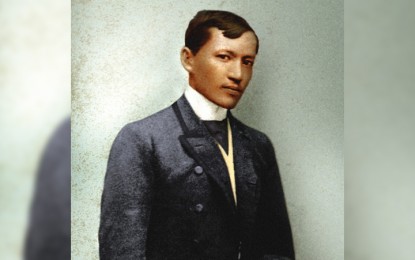
Dr. Jose Rizal
By Geronimo Suliguin
MANILA – Today, as we commemorate his 159th Birth Anniversary under the uncertainties of Covid-19, Dr. Jose P. Rizal, by his examples, reminds us once again to stick to the right path and try not to go astray -- to keep our firm resolve against all odds and to be of service as usual to the fatherland.
One hundred and thirty years ago, in 1890, the 28-year old Jose Rizal arrived in Paris from London on 18 January after spending a few days there since the 6th looking for books. He just published his Annotations of Morga's Sucesos de las Islas Filipinas at a time when Paris, like London, was suffering from "Die influenza" which was "wreaking havoc" in much of Europe.
The influenza epidemic of 1889–90 was the largest 19th century epidemic of influenza which arrived in Europe from the east in November and December of 1889.
It was so widely commented on in the press with the greatest attention in the cities of Paris and London where Rizal was during the period.
It has been hinted that the influenza reached Paris sometime at the turn of November and December of 1889 when Rizal was busily preparing the printing of his Annotations. In Parisian newspapers Le Matin and Le Temps, the influenza was the topic from end of November until two months later.
The papers reported a mysterious disease that appeared in the middle of December among different shop assistants of the well-known Parisian store Louvre’ - Grands Magasins du Louvre - some 1.5 kilometers away from where Rizal lived at 45 Rue de Maubeuge.
Come Christmas week, the influenza epidemic assumed a "more serious nature" with the disease reportedly often ending with pneumonia and the hospitals incapable of accommodating "such an enormous number of patients". Some 200 more people died in Paris that week than in the previous one.
It may have been rather fortunate that the copies of Rizal's Morga came out of the press about the 23rd of December. The road to the publisher, Libreria de Garnier Hermanos at 6 Rue Des Saints-Peres, directly passes through the Louvre area. His admission permit to the Bibliotheque Nationale which was also in the vicinity of the Louvre shops expired on this date, sparing him from unnecessarily being exposed.
When Rizal got back from London in January, a decrease in the Parisian epidemic was also noted in the French newspapers. Rizal, thus, was spared, not having caught the fever nor any malaise either in London or in Paris.
'Letter to Blumentritt'
In his 20 January 1890 letter to Blumentritt, he thanked God he only had to endure "a few minutes of headache" or the illness would have given his enemies "an occasion to say jubilantly that it is God's punishment" for having attacked the men of the cloth and the Catholic Church in his novel Noli Me Tangere and the recently published Annotations. Rizal also revealed how he would have laughed at his accusers as such allegations would be blasphemy.
In his letter of even date, Rizal took note of the conversation between Pardo de Tavera and the Jesuit priest Fr. Federico Faura (yes, the very priest Padre Faura St. was named after). Padre Faura used to be the Director of the Observatorio Meteorológico de Manila, or Manila Observatory, that was located along the street, the space now occupied by a mall, and gave it its former name - Observatorio Street.
Rizal told Blumentritt that the Jesuit priest exclaimed upon learning Rizal was "slightly ill" that "It cannot be otherwise; a man like him has to die!" Rizal admitted that it was not good for the Jesuit to say such "nonsense" but also hinted on the likely reason why the Padre may have wished that way.
Rizal had spoken with Padre Faura the last time he was in Manila.
In their conversation, the priest made known to Rizal that what he had written in the Noli was the truth, the bitter truth, and the sad conditions of the time. To him, Noli has "nothing of the novel in it". And for writing what was the truth, God will punish Rizal with death, like Zeus chaining Prometheus to a rock for giving men the gift of fire.
Recalling this incident, the Filipino nation should be grateful that Rizal did not succumb to the influenza epidemic of 1889-90. More than this, the country should be equally thankful that the influenza epidemic did not hinder the young Rizal's sense of purpose.
At a time when death was near and ever-present in Paris, Rizal was busily writing for La Solidaridad with his essays "Filipinas Dentro de Cien Años" and the poem "Las Flores de Heidelberg" both published in December, and saw to it that he sent out a copy of his Annotations to Mariano Ponce in Barcelona.
For Rizal, epidemic or not, it was service as usual. This resolve of a young man to combat with all his strength the primary cause of all the sufferings and tears in his country wherever, whenever, and whatever the condition was is what makes our National Hero still relevant to this day and age.
Rizal did not hesitate to fight the enemy that hid behind the false religion.
The young Rizal dared to speak truth to power and paid for it with his life. He preferred truth to his fame. His only wish was for his countrymen to sacrifice their passions on the altar of the country, and to seek their welfare in the virtues that distinguish and adorn free peoples. Non Omnis Moriar! (PNA)
(About the author: Geronimo Suliguin, Knight Commander of Rizal, took postgraduate courses in historical and diplomatic studies at Oxford University. He is the Assistant Director at the Department of Foreign Affairs- Maritime and Ocean Affairs Office)
